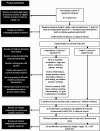The development, feasibility and acceptability of a school-based obesity prevention programme: results from three phases of piloting
- PMID: 22021732
- PMCID: PMC3191390
- DOI: 10.1136/bmjopen-2010-000026
The development, feasibility and acceptability of a school-based obesity prevention programme: results from three phases of piloting
Abstract
Objectives: To develop a school-based obesity prevention programme and evaluate the feasibility and acceptability of the intervention and the planned definitive cluster randomised trial.
Design: This was a three stage pilot involving six schools (398 children) in South West England, including an exploratory randomised controlled trial and qualitative interviews and focus groups with teachers, parents and children.
Intervention: The Healthy Lifestyle Programme uses a range of school-based activities including lessons, assemblies, parents' evenings, interactive drama workshops and goal setting to engage schools, children and their families.
Results: Of the 398 eligible children in the three pilot phases, only four opted out and a further three withdrew from the exploratory trial. In the exploratory trial, baseline measurements (anthropometric and behavioural) were obtained for 202/204 eligible children in four schools and both 18- and 24-month outcome measurements for 193/204 and 187/204 participants, respectively. Qualitative data show that delivery of the intervention is feasible within schools and acceptable to teachers, children and families. In the exploratory trial, 18/80 children (24%) in the intervention schools and 31/122 (26%) in the control schools were overweight or obese at baseline, increasing, at 18-month follow-up, to 38/119 (32%) in the control schools compared with 18/74 (24%) in the intervention schools. At 24 months the proportion of overweight and obese children in the control schools remained at 32% (36/114), whereas the proportion in the intervention schools decreased slightly to 22% (16/73).
Conclusion: The Healthy Lifestyle Programme is feasible to deliver and acceptable to schools, children and their families. We recruited, retained and obtained outcome measurements from 92% of eligible children in the exploratory trial, including measurements taken after transition to secondary school, suggesting that a definitive trial is likely to be deliverable.
Conflict of interest statement
Figures
References
-
- Health Survey for England 2008 Trend Tables. The NHS Information centre, 2009, http://www.ic.nhs.uk/pubs/hse08trends
-
- National Child Measurement Programme: Results from the School Year 2009/10: http://www.ic.nhs.uk/statistics-and-data-collections/health-and-lifestyl...
-
- Gunnell DJ, Frankel SJ, Nanchahal K, et al. Childhood obesity and adult cardiovascular mortality: a 57-y follow-up study based on the Boyd Orr cohort. Am J Clin Nutr 1998;67:1111–18 - PubMed
-
- Serdula MK, Ivery D, Coates RJ, et al. Do obese children become obese adults? A review of the literature. Prev Med 1993;22:167–77 - PubMed
Publication types
Grants and funding
LinkOut - more resources
Full Text Sources



